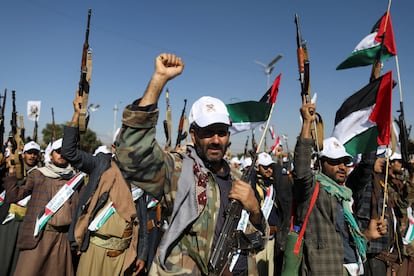US-Iran tensions escalate in the shadow of Gaza war
Tehran-backed factions such as Yemen’s Houthis are intensifying their attacks against Israeli and U.S. interests, while Washington has increased its deployment in the region

The end of the fragile ceasefire between Hamas and Israel in Gaza has reignited tensions between the United States and groups supported by Iran in different parts of the Middle East. These clashes are taking place amid the Israeli military’s fierce offensive on the Gaza strip, which is threatening to turn into a broader regional conflict.
Tension between the U.S. and Iran rose significantly on Sunday, when Yemen’s Houthi movement, which is supported by Iran, launched four ballistic missiles and drone attacks against three commercial ships sailing through the strategic Red Sea, according to the U.S. military’s Central Command (CentCom). The attacks caused no injuries, but a U.S. warship had to be deployed in the area to intervene. Washington argued that the actions were “fully enabled by Iran.” “These attacks represent a direct threat to international commerce and maritime security,” CentCom said in a statement.
The first of these attacks occurred early Sunday morning, when several missiles fired from areas of Yemen controlled by Houthi forces struck near a Bahamas-flagged cargo ship, according to CentCom. Around noon, the U.S. warship deployed in the area shot down a drone launched from the same territory. It was heading in its direction, although the target is unclear. A few minutes later, the cargo ship was hit by another missile from Yemen and attacked with a drone that was shot down.
In the afternoon, a second commercial ship and a bulk carrier, both Panamanian-flagged, were attacked from Houthi-controlled territory, and the U.S. warship shot down another drone heading toward it, according to CentCom. Houthi spokesman Yahya Saree claimed responsibility for the attacks on two commercial ships, claiming that they were Israeli. He said that his forces consider Israeli ships — as well as those with Israeli ties — as a “legitimate target” until Israel stops its offensive against Gaza.
In the week prior to these attacks, four other incidents were recorded on the high seas. Two of them were similar attacks launched from areas controlled by the Houthis against a Liberian-flagged oil tanker and a U.S. aircraft carrier and warship, according to CentCom. The other two episodes involved a second U.S. aircraft carrier that was targeted in the Persian Gulf by Iranian speedboats and drones, U.S. Naval Forces Central Command and Iran’s Revolutionary Guard reported.
The largest assault by the Houthis took place on November 19, when a group of heavily armed militiamen took control of a commercial freighter partially owned by an Israeli shipowner after overtaking it with a helicopter. Before the start of the ceasefire in Gaza, the Houthis launched at least nine direct attacks against Israel, but all were intercepted, except for two that mistakenly hit two Egyptian towns in the Red Sea.
Groups in Syria and Iraq
Since the end of the ceasefire in Gaza, groups close to Iran have also resumed activity in Syria and Iraq. At least two bases with a U.S. presence in northeastern Syria have been attacked with rockets since Friday, according to the Pentagon. And on Sunday, the United States attacked members of an Iranian-backed militia in northern Iraq who were preparing to launch an assault. Five of the members were killed, according to a group made up of several Iraqi armed factions.
Between mid-October and the start of the ceasefire in Gaza, Iranian-backed militias in Syria and Iraq attacked U.S. positions on at least 74 occasions, according to the Pentagon, which reported more than 60 minor injuries. An American contractor died during a false alarm. The United States, for its part, has acknowledged about 15 attacks in eastern Syria and three in Iraq, one of which killed nearly a dozen members of a pro-Iran militia.
The clashes between the United States and this constellation of armed groups in Iraq and Syria were initially limited in scope as both sides attempted to minimize the risk of the violence spiraling out of control. But in the days leading up to the ceasefire in Gaza, both sides became more aggressive. In this context, Iraqi Prime Minister Mohammed al Sudani condemned the attacks on Iraqi territory in a call with U.S. Secretary of State Antony Blinken on Saturday.
Since Israel launched its military operation on Gaza, Washington has sent two aircraft carriers to the Middle East, including the largest in the world, with thousands of troops on board. These are supported by several warships, some of which have been involved in the recent clashes. The United States also announced that it is sending a submarine, despite the fact that these usually operate covertly, and also deploying new air defense systems and 1,200 soldiers. Before the Israeli attack on Gaza, the United States had about 2,500 troops in Iraq and 900 in Syria, as part of the international coalition against Islamic State.
The Pentagon argues that this strong reinforcement of its military capabilities in the Middle East is aimed at meeting four main objectives: dissuading Iranian-backed groups from opening new fronts beyond Gaza; reinforcing Israel’s security during its military operation in the Strip; and protecting its troops in the region, as well as its citizens.
Sign up for our weekly newsletter to get more English-language news coverage from EL PAÍS USA Edition
Tu suscripción se está usando en otro dispositivo
¿Quieres añadir otro usuario a tu suscripción?
Si continúas leyendo en este dispositivo, no se podrá leer en el otro.
FlechaTu suscripción se está usando en otro dispositivo y solo puedes acceder a EL PAÍS desde un dispositivo a la vez.
Si quieres compartir tu cuenta, cambia tu suscripción a la modalidad Premium, así podrás añadir otro usuario. Cada uno accederá con su propia cuenta de email, lo que os permitirá personalizar vuestra experiencia en EL PAÍS.
¿Tienes una suscripción de empresa? Accede aquí para contratar más cuentas.
En el caso de no saber quién está usando tu cuenta, te recomendamos cambiar tu contraseña aquí.
Si decides continuar compartiendo tu cuenta, este mensaje se mostrará en tu dispositivo y en el de la otra persona que está usando tu cuenta de forma indefinida, afectando a tu experiencia de lectura. Puedes consultar aquí los términos y condiciones de la suscripción digital.
More information
Archived In
Últimas noticias
Most viewed
- Reinhard Genzel, Nobel laureate in physics: ‘One-minute videos will never give you the truth’
- Oona Chaplin: ‘I told James Cameron that I was living in a treehouse and starting a permaculture project with a friend’
- Pablo Escobar’s hippos: A serious environmental problem, 40 years on
- Why we lost the habit of sleeping in two segments and how that changed our sense of time
- Chevy Chase, the beloved comedian who was a monster off camera: ‘Not everyone hated him, just the people who’ve worked with him’










































